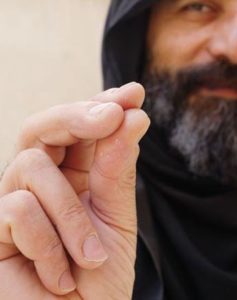 The sign of the cross is a beautiful gesture which reminds the faithful of both the cross of salvation while invoking the Holy Trinity.
The sign of the cross is a beautiful gesture which reminds the faithful of both the cross of salvation while invoking the Holy Trinity.
The early Church Fathers attested to the use of the sign of the cross. Tertullian (d. 250) described the exceptional frequency of the sign of the cross being made:
“In all our travels and movements, in all our coming in and going out, in putting on our shoes, at the bath, at the table, in lighting our candles, in lying down, in sitting down, whatever employment occupies us, we mark our foreheads with the sign of the cross” (De corona, 30).
St. Cyril of Jerusalem (d. 386) in his Catechetical Lectures stated,
“Let us then not be ashamed to confess the Crucified. Be the cross our seal, made with boldness by our fingers on our brow and in everything; over the bread we eat and the cups we drink, in our comings and in our goings out; before our sleep, when we lie down and when we awake; when we are traveling, and when we are at rest” (Catecheses, 13).
Even much later, an instruction of Pope Innocent III (1198-1216) evidences the traditional practice but also indicates a shift in the Latin Rite practice of the Catholic Church:
“The sign of the cross is made with three fingers, because the signing is done together with the invocation of the Trinity. …This is how it is done: from above to below, and from the right to the left, because Christ descended from the heavens to the earth, and from the Jews (right) He passed to the Gentiles (left).”
Until then, the custom of making the cross from the right to the left shoulder was the common practice for all Christians in both the western and eastern Church.
